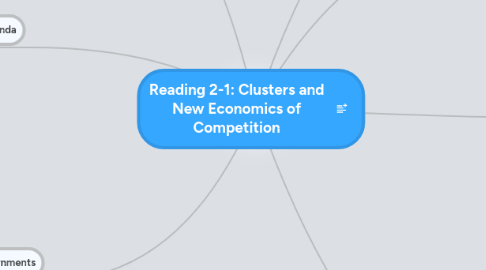
1. Paradox: Secret to success in global economy lies increasingly in local stuff that distant rivals can't match
1.1. Advantages of cheaper inputs can be mitigated through global sourcing, advantage of better use of these inputs can not
2. New issues for strategic agenda
2.1. 1. Choosing Locations
2.1.1. Companies have often moved to low wage countries where they have no cluster effects
2.1.2. Location important for innovation
2.1.3. Cluster especially crucial for "home base" where R&D, strategy development.. take palce
2.1.4. Move groups of linked activities of your company to same place
2.2. 2. Engaging Locally
2.2.1. Getting important tacit knowledge from clusters requires f2f communication and "insider" status
2.2.2. Companies need strong local presence to maximize cluster benefits
2.3. 3. Upgrading the Cluster
2.3.1. Health of local business environment is crucial for health of cluster
2.4. 4. Working Collectively
2.4.1. Trade associations just lobby and look for government benefits
2.4.1.1. Instead should be forum to exchange ideas and collectively overcome obstacles
2.4.1.1.1. Flower auction house in holland
3. New Roles of Governments
3.1. Must ensure high-quality inputs like educated people and infrastructure
3.2. Must set rules of competition through antitrust laws etc
3.3. Should promote cluster formation and upgrading
3.3.1. Rather focus on improving existing clusters than formation of new ones
4. Promote both competition and cooperation
4.1. Cooperation mostly vertical
4.2. Competition is mostly horizontal
4.3. Competition and cooperation can coexist because they happen in different dimensions
5. Promote competition
5.1. Increase productivity of companies in the area
5.1.1. More productive sourcing of inputs
5.1.2. Better access to employees and suppliers
5.1.3. Access to specialized information
5.1.4. Complementaries
5.1.4.1. Good performance of one company boosts others
5.1.4.2. Companies more likely to recognize important links between each other
5.1.4.3. Cluster increases popularity of a location in a given field so buyers will rather look for a vendor there
5.1.4.4. Clusters are attractive to buyers because they can visit many vendors at once
5.1.5. Access to Institutions and Public Goods
5.1.6. Better motivation and measurement
5.1.6.1. Local rivalry stimulates competition
5.1.6.2. Easier benchmarking
5.2. Drives direction and speed of innovation
5.2.1. Sophisticated buyers are often part of cluster so companies in cluster have good view into market
5.2.2. Companies can source more quickly
5.3. Stimulates the formation of new businesses
5.3.1. People in cluster see niches better
5.3.2. Local financing institutions already familiar with industry
6. Alternative way of organizing the value chain
6.1. More flexible than vertical integration
6.2. Close proximity of companies fosters coordination and trust
6.3. Trust and coordination of vertical integration but at the same time flexible!
7. Development
7.1. Birth
7.1.1. Often from historical circumstances
7.1.2. One or two innovative companies stimulate growth of others
7.2. Evolution
7.2.1. Cluster is self reinforcing
7.2.2. The most vibrant where two clusters meet
7.3. Decline
7.3.1. External forces
7.3.1.1. Technological discontinuity
7.3.1.2. Government Restrictions
7.3.1.3. Shift in buyer's needs in rest of world compared to people around cluster
7.3.2. Internal forces
7.3.2.1. Overconsolidation
7.3.2.2. Cartels
7.3.2.3. Groupthink

